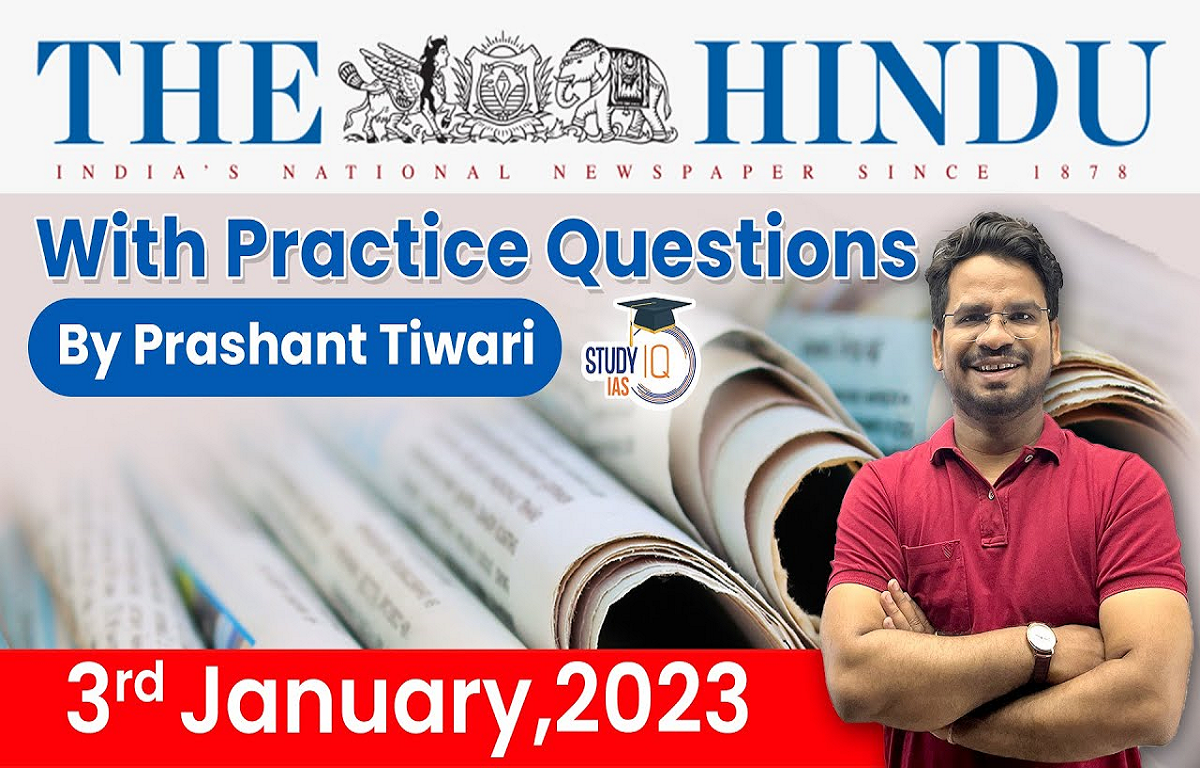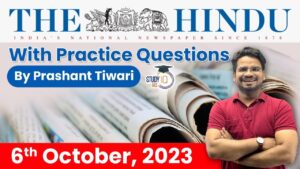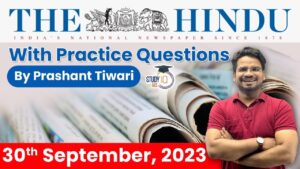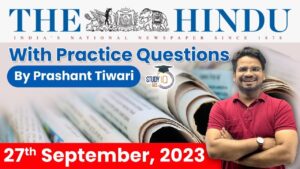The Hindu Newspaper Analysis for UPSC

The Hindu Newspaper Analysis 2 January 2023

The Hindu Editorial Today
- A majority of four judges on a Constitution Bench of the Supreme Court on Monday found no flaw in the Union government’s process to demonetise ₹500 and ₹1,000 banknotes through a Gazette notification issued on November 8, 2016.
- The sole woman judge on the five-member Bench, Justice B.V. Nagarathna, however, disagreed with the majority, saying the government’s notification issued under Section 26(2) of the Reserve Bank of India (RBI) Act was unlawful.
- Justice B.R. Gavai, delivering the judgment for the majority, which included Justices S. Abdul Nazeer, A.S. Bopanna, and V. Ramasubramanian, pronounced that the statutory procedure under Section 26(2) was not violated merely because the Centre had taken the initiative to “advise” the Central Board to consider recommending demonetisation.
- Differing, Justice Nagarathna said the Centre could have issued a notification under Section 26(2) only if the Central Board of the RBI had initiated the proposal to demonetise a specified series of banknotes by way of a recommendation. Here, in 2016, the government had initiated the demonetisation, not the Central Board.
- In cases in which the government initiates demonetisation, Justice Nagarathna said, it should take the opinion of the Central Board. The opinion of the Board should be “independent and frank”. If the Board’s opinion was in the negative, the Centre could still go forward with the demonetisation exercise, but only by promulgating an ordinance or by enacting parliamentary legislation.

- State management of temples is often justified as a way of ensuring access to temples for worshippers and archakas (priests). Regulating secular activities associated with religious practice can be traced to Article 25(2)(a) of the Constitution. Temple control legislation is purportedly justified by this Article.
- However, the framers of the Constitution, being aware of the temple entry movement, advisedly provided a separate power under Article 25(2)(b) which empowers the state to enact laws “providing for social welfare and reform or the throwing open of Hindu religious institutions” to “all classes and sections of Hindus”.
- Hence, the issue of regulating secular aspects of religious practice is distinct from providing access to worship. This is why there are separate laws for temple control and temple entry. They co-exist; one does not depend on the other.
- The Hindu Religious and Charitable Endowments (HR&CE), 1959, is the governing law on the administration of Hindu temples and religious institutions.
- A long line of judicial precedents, post the 42nd Amendment, emphasise that secularism means the state cannot mix with religion. Whatever brand of secularism you subscribe to, nothing justifies a state official dictating to a religious functionary how worship is to be conducted.
- It is fashionable for supporters of temple control laws to question how temples will be handed to the communities. This begs the question of whether something illegal in its original form can become legal over time. The purpose is to involve the community, which has been excluded by the state. The objective is not to replace one bureaucracy with another. The participation of different stakeholders and the building of consensus among them will determine who will take over temples.
- Article 25(2)(a) empowers the state to regulate “economic, financial, political or other secular activities which may be associated with religious practice”.
- Article 25(2)(b) empowers the state to enact a law to prohibit the exclusion of ‘classes and sections’ of Hindu society to enter into Hindu temples of a public character and also make law for social welfare and reform.
- However, these safeguards are being misused by the state to assume ownership of properties belonging to religious institutions.

- The Government of India is paying special attention to the development of border villages, especially from a security perspective. Union Home Minister Amit Shah said on December 29 that borders could be permanently secured only when border villages are populated by patriotic citizens who are concerned for the country.
- Shah asked the Border Security Force (BSF) to effectively use the Vibrant Village Programme (VVP), announced by the Centre in the 2022 Budget, to promote development and communication in border villages.
- The scheme is for funding development of “border villages with sparse population, limited connectivity and infrastructure (that) often get left out from the development gains,” Finance Minister Nirmala Sitharaman had said in her Budget speech in 2022.
- One year after it was announced, there is little clarity on the details of VVP, including on the question of whether it will cover all border areas or only the northern border with China as mentioned in the Budget.
- The government has said VVP would cover construction of village infrastructure, housing, tourist centres, road connectivity, provisioning of decentralised renewable energy, direct-to-home access for Doordarshan and educational channels, and support for livelihood generation.

- At the Constitution Day celebrations organised by the Supreme Court in November 2022, President Droupadi Murmu shared a snippet of her journey with the audience. She reflected on her visits to prisons across India and the circumstances of those incarcerated.
- She highlighted that these individuals were often unaware of their fundamental rights and had been incarcerated for prolonged periods for minor offences, while their families, struggling with poverty, were unable to bail them out.
- French philosopher Michel Foucault has extensively written about how the architecture of prisons is often used as a tool to surveil, torture, and break the souls of inmates.
- Prisons in India are still governed by the Prisons Act, 1894, a colonial legislation which treats prisoners as sub-par citizens, and provides the legal basis for punishment to be retributive, rather than rehabilitative.
- These laws are also highly casteist, and remain largely unchanged since they were drafted by the British. For example, some jail manuals continue to focus on purity as prescribed by the caste system, and assign work in prison based on the prisoner’s caste identity.
- The primary reason why prisons are overcrowded is because India has not done enough to truly prevent crime. Our approach to crime should be preventive, rather than reactive.


- The scale of exports by India is still miniscule and about 200 times smaller than that of China’s.
- Amid the COVID-19 pandemic in August 2020, Prime Minister Narendra Modi exhorted that India can become a global toy hub. In July 2021, he rued the fact that about 80% of the toys were imported, with crores of rupees going abroad, calling on people to be “vocal for local toys”.
- In July 2022, he announced that India’s exports of toys surged from ₹300-400 crore to ₹2,600 crore, a boost that “no one could have imagined.” Beyond an increase in exports, Mr. Modi also said that imports of toys, which used to be over ₹3,000 crore, has fallen by 70%, signifying a drop in India’s reliance on foreign-made toys — especially from China.
- One of the major reasons behind the decline was the increase of Basic Customs Duty on import of toys from 20% to 60%. Also, stringent conditions were imposed on the quality of imported toys.
Q) Consider the following statements regarding Inter-state Council.
- The Constitution gives powers to the Parliament to set up an Inter-state Council for resolution of disputes between states.
- The Sarkaria Commission suggested that the Council should exist as a permanent body.
Which of the above statements is/are correct?
- 1 only
- 2 only
- Both 1 and 2
- Neither 1 nor 2
अंतर-राज्य परिषद के संबंध में निम्नलिखित कथनों पर विचार करें।
- संविधान संसद को राज्यों के बीच विवादों के समाधान के लिए अंतर-राज्यीय परिषद गठित करने की शक्ति देता है।
- सरकारिया आयोग ने सुझाव दिया कि परिषद एक स्थायी निकाय के रूप में मौजूद होनी चाहिए।
उपरोक्त कथनों में से कौन-सा/से सही है/हैं?
- केवल 1
- केवल 2
- 1 और 2 दोनों
- न तो 1 और न ही 2
- Inter-state Council: Article 263 of the Constitution gives powers to the President to set up an Inter-state Council for resolution of disputes between states.
- The Council is envisaged as a forum for discussion between the states and the Centre.
- In 1988, the Sarkaria Commission suggested that the Council should exist as a permanent body, and in 1990 it came into existence through a Presidential Order.
Q) Consider the following statements regarding Dr. R. Ambedkar.
- Mahaparinirvan Diwasis observed to commemorate the death anniversary of B R Ambedkar.
- He founded the Bahishkrit Hitkarini Sabha.
Which of the above statements is/are correct?
- 1 only
- 2 only
- Both 1 and 2
- Neither 1 nor 2
डॉ आर अम्बेडकर के संबंध में निम्नलिखित कथनों पर विचार करें।
- बी आर अम्बेडकर की पुण्यतिथि मनाने के लिए महापरिनिर्वाण दिवस मनाया गया।
- उन्होंने बहिष्कृत हितकारिणी सभा की स्थापना की।
उपरोक्त कथनों में से कौन-सा/से सही है/हैं?
- केवल 1
- केवल 2
- 1 और 2 दोनों
- न तो 1 और न ही 2
- Mahaparinirvan Diwas is observed every year on December 6 to commemorate the death anniversary of Dr. B R Ambedkar.
- He founded the Bahishkrit Hitkarini Sabha (1923).
Round table conferences: He participated in all three round-table conferences.
Q) Consider the following statements regarding the jurisdiction of the Supreme Court of India.
- It has the jurisdiction to issue writs under Article 32 of the Constitution.
- It has the original jurisdiction under Article 131 of the Constitution.
Which of the above statements is/are Incorrect?
- 1 only
- 2 only
- Both 1 and 2
- Neither 1 nor 2
भारत के सर्वोच्च न्यायालय के अधिकार क्षेत्र के संबंध में निम्नलिखित कथनों पर विचार करें।
- इसे संविधान के अनुच्छेद 32 के तहत रिट जारी करने का अधिकार है।
- संविधान के अनुच्छेद 131 के तहत इसका मूल अधिकार क्षेत्र है।
उपरोक्त में से कौन सा/से कथन गलत है/हैं?
- केवल 1
- केवल 2
- 1 और 2 दोनों
- न तो 1 और न ही 2
Explanation:
- The Supreme Court of India is regarded as the world’s most powerful top court, on account of its wide power of judicial review.
- It has the jurisdiction to issue writs under Article 32 of the Constitution. It also has the original jurisdiction under Article 131 of the Constitution.
- There is also wide appellate power under Articles 132, 133, 134 and 136 of the Constitution. More significantly, the Supreme Court has the power to “make such an order as is necessary for doing complete justice in any cause or matter pending before it”, as per Article 142 of the Constitution.
Q) Consider the following statements about the Central Pollution Control Board of India:
- It is a statutory organization under the Ministry of Environment, Forest and Climate Change.
- It was established under the Environment (Protection) Act, 1986.
Which of the above statements is/are correct?
- 1 only
- 2 only
- Both 1 and 2
- Neither 1 nor 2
भारतीय केंद्रीय प्रदूषण नियंत्रण बोर्ड के बारे में निम्नलिखित कथनों पर विचार करें:
- यह पर्यावरण, वन और जलवायु परिवर्तन मंत्रालय के तहत एक वैधानिक संगठन है।
- इसकी स्थापना पर्यावरण (संरक्षण) अधिनियम, 1986 के तहत की गई थी।
उपरोक्त कथनों में से कौन-सा/से सही है/हैं?
- केवल 1
- केवल 2
- 1 और 2 दोनों
- न तो 1 और न ही 2
Explanation:
- PCB is a statutory organisation which was constituted in September 1974 under the Water (Prevention and Control of Pollution) Act, 1974.
- It was entrusted with the powers and functions under the Air (Prevention and Control of Pollution) Act, 1981.
- It serves as a field formation and also provides technical services to the Ministry of Environment and Forests under the provisions of the Environment (Protection) Act, 1986
- Important functions:
- to promote the cleanliness of streams and wells in different areas of the States by prevention, control and abatement of water pollution.
- to improve the quality of air and to prevent, control or abate air pollution in the country.
Mains Practice Question:
Q) What are the present challenges before crop diversification? How do emerging technologies provide an opportunity for crop diversification? (150 words)
फसल विविधीकरण के सामने वर्तमान चुनौतियाँ क्या हैं? उभरती प्रौद्योगिकियां फसल विविधीकरण के लिए अवसर कैसे प्रदान करती हैं? (150 शब्द)
Introduction:
- Crop diversification refers to the addition of new crops or cropping systems to agricultural production on a particular farm taking into account the different returns in socio-economic and environmental terms. Due to diverse set of climates, soil types and cultures, India has diverse range of cropping systems.
Body:
The challenges before crop diversification:
- Impact of Green Revolution: There has been shift towards Mono cropping of wheat and rice at cost of coarse grains (Government policy of MSP).
- Monsoon Dependence: Around 55% of India’s Cultivable Land is Rain-fed with heavy dependence on monsoon.
- Fragmented land holding: It makes it difficult to use efficient modern technology on large scale, raises cost of land boundary management, land disputes etc.
- Shift from Food crops to Commercial Crops: This especially includes Cotton in Deccan belt; and Sugarcane in Green revolution belt and Krishna-Godavari basin.
Emerging Technologies and opportunities provided by them:
- IT Revolution: It is helping to connect farmers directly with grocery-customers ( farm to fork model) leading to cultivation of high value perishable products (e.g Big Basket, BlinkIt startup platforms)
- Aquaponics and Urban Farming: To meet the heavy urban demand for Persisahble items, this technique of controlled environment cultivation is helping in crop diversification.
- Financial Inclusion and Digitization: It has helped small farmers, women SHGs to ensure crop diversification through credit supply.
- Irrigation: PM Krishi Sinchai Yojna has ensured access to micro irrigation (Per Drop More Crop), drip irrigation, sprinklers etc.
- Dryland Agriculture: Indo-Israel Agriculture Project has introduced technologies like Urea Deep Placement (UDP), Poly-bag Nursery farming etc in arid areas(e.g Rajasthan has seen cultivation of strawberries and olives).
- Soil Health Management: It has helped ensuring right Fertilizer usage, developing Organic Framing, providing GIS based thematic mapping for soil.(e.g. Soil Health Card)
Mains Practice Question:
Q) Are we losing our local identity for the global identity? Discuss. (150 words)
क्या हम वैश्विक पहचान के लिए अपनी स्थानीय पहचान खो रहे हैं? विचार-विमर्श करना। (150 शब्द)


 The Hindu Newspaper Analysis 6 October 2...
The Hindu Newspaper Analysis 6 October 2...
 The Hindu Newspaper Analysis 30 Septembe...
The Hindu Newspaper Analysis 30 Septembe...
 The Hindu Newspaper Analysis 27 Septembe...
The Hindu Newspaper Analysis 27 Septembe...





















